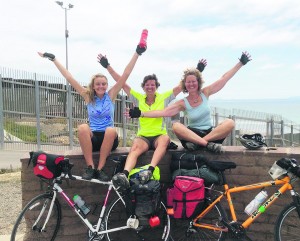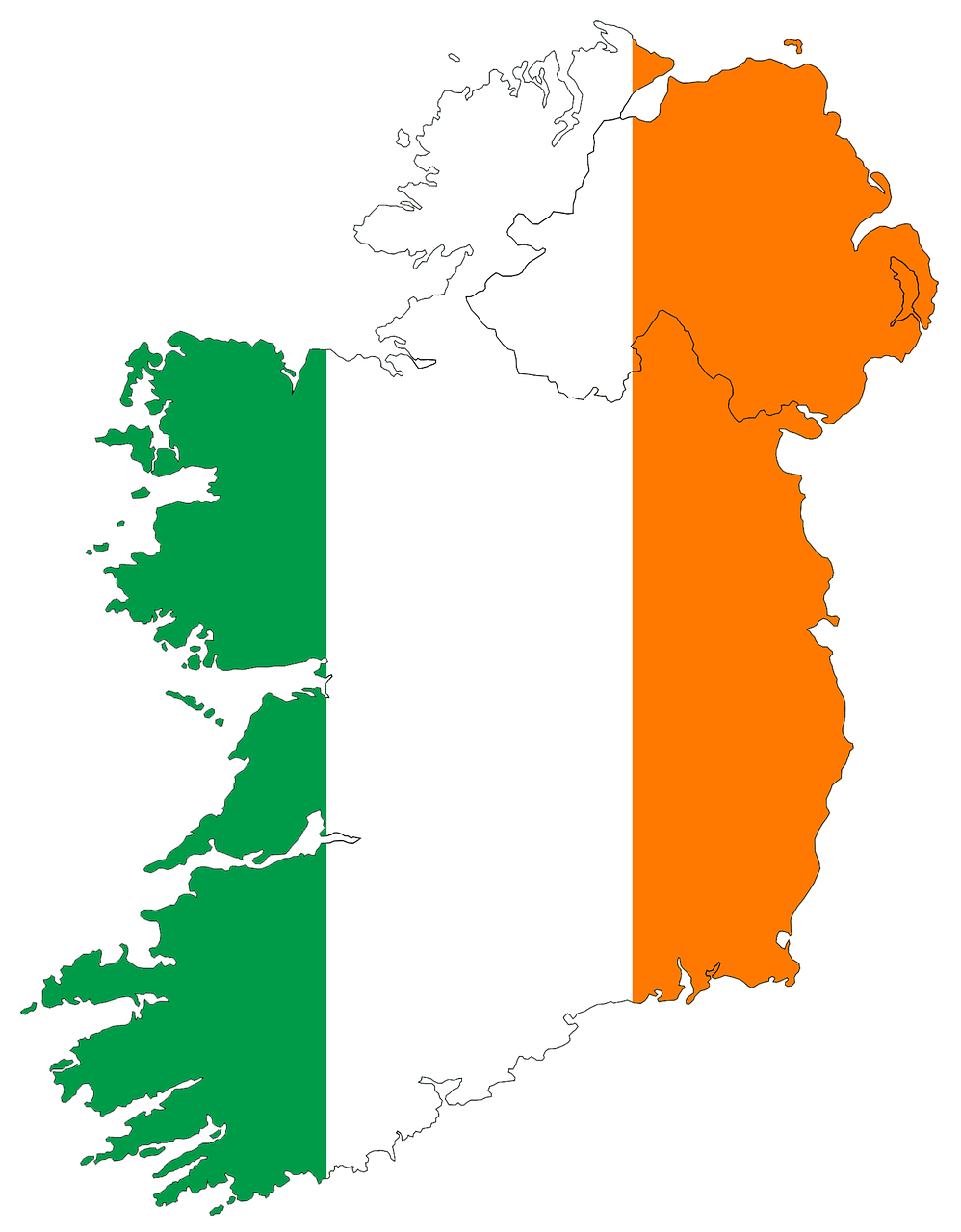 Patrician Academy teacher, Regina Glynn, along with her sister Sherleen Andrew and a friend, Lucy Corcoran, this summer cycled 2,000 miles along the famous Pacific coast highway from Canada to Mexico. Following this amazing experience, Sherleen and Regina will give a presentation and slide show about the trip, in the Hibernian Hotel on Saturday, 18th October at 8pm. All are welcome and donations will be given to the Irish Hospice. The following is Regina’s reflections on the marathon cycle.
Patrician Academy teacher, Regina Glynn, along with her sister Sherleen Andrew and a friend, Lucy Corcoran, this summer cycled 2,000 miles along the famous Pacific coast highway from Canada to Mexico. Following this amazing experience, Sherleen and Regina will give a presentation and slide show about the trip, in the Hibernian Hotel on Saturday, 18th October at 8pm. All are welcome and donations will be given to the Irish Hospice. The following is Regina’s reflections on the marathon cycle.
Why did I go on the cycling trip? I have wanted to do it since I was 21 years old. That year I was on a J1 visa in the U.S.A. and after working for ten weeks we spent three weeks travelling across America and down the Pacific Coast Highway. I visited it again in 1984 and was really impressed by the number of people cycling from Canada to the Olympics in Los Angeles. I attempted to plan it for my 50th birthday but was very ill with cancer. Time was passing and I thought I might try and get a group together. I put word around and two people expressed interest. My sister Sherleen, and Lucy, a daughter of a very good friend, were keen to try. We met on many occasions, drew up a calendar of events, mapped the route and sorted out tickets and insurance. Bikes, tent, thermrest and panniers were organised and packed. After many, many phone calls, emails and coffees, we were ready for the Pacific Coast Highway. We had a fantastic summer. It lived up to all my expectations and more. There were so many times I found myself saying ‘is this for real, life doesn’t get much better than this’. Particularly when cycling downhill, a soft wind blowing in my face and an amazing view of the sea. I must have said that lots of times while cycling the Oregon coast.
Cork – Vancouver
The first leg of our journey was the flights from Cork/London/Calgary/Vancouver. We rested for three days in Vancouver with friends who showed us around this magnificent city. My resounding memory was the real sense of clean, fresh air and blue everywhere, the blue of the sky, the sea, and the reflection of both in the glass buildings. Everywhere seemed to be walkable. We arrived and within ten minutes walk I was swimming and walking the beach. If one wished, one could walk in other directions and be downtown or in Stanley Park. We walked in this beautiful park, which contains the famous sea wall and is popular for jogging, biking and rollerblading. From there we crossed the famous Lions Bridge and began our hike up on Grouse Mountain. This is a ski resort in winter with chairlift etc. with breathtaking panoramic views of the city, sea and surrounding mountains. We visited the Museum of Anthropology at the University of British Columbia. It contains one of the finest collections of native art in Canada and throughout the world. We did not unpack the bikes as we needed them boxed for the ferry, bus and ferry journey. The ferry trip was relaxing after such an early start, passing the San Juan Islands, Vancouver to Vancouver Island. We travelled from Sidney by bus to Victoria where we unpacked the bikes, which took us an hour and a half. This was a tricky operation as we had not done it before. We had to reconnect wheels, handlebars, saddles and carriers, pack panniers and bar bags and attach them to the bikes. This was so exciting as it was the real start of our odyssey. We had our bikes checked to make sure everything was in the correct place, by a local bicycle shop in Victoria. From there we cycled to the Coho ferry and sailed to America.
Washington Coast
We landed in Washington State at Port Angles for the second leg of our journey. The length of this element of the trip was approximately 380 miles as we did a number of side trips. It took us six days. Having landed, we cycled to the K.O.A Camp ground, as there was no state park nearby. It was our first time erecting the tent, which was a learning curve for me as I had done little camping in about twenty years. The tent was very light and the poles were all elasticated which made them easy to set up. Our thermrest (ultra modern self inflating air mattresses) sleeping bags were lightweight and warm. Apart from the midges, all went according to plan; they drove us nuts! Every night we ended up covering ourselves from head to toe. That night we were so tired we would have slept on a bed of nails as we had been up since 5.30am.
The next day was our first real cycle. We cycled 51 miles, which does not sound like much but when you have panniers and tent on the bike, it is a heavy load so we did quite well. The route skirted the Olympia National Park, a place renowned for its snow-covered mountains, trees and wildlife. Here we had our first encounter with the logging trucks. Logging is a major industry and the giant trucks were a great sight with the vintage look of the cabins, painted bright colours and chrome finish. The smell of freshly-cut timber was always welcome on the road. We followed the Hood Canal (a spur of Puget Sound), famous for its huge clams and shrimps. Our first State Park was Dosewallip where we were invited to join our neighbours. They asked us to sit at their campfire and taste traditional s’mores which are toasted marshmallows dipped in melted chocolate and placed between two biscuits. This is a very sweet treat. We sat around the campfire, swapping stories about traveling, cycling and the state of teaching in America and Ireland.
In the following days we headed to the coast, passing through familiarly-named towns, Aberdeen, Westport and Raymond, of course we had to stop there! We cycled by Indian reservations, through wildlife reserves, and met one of the most interesting characters of all on our trip, Ken from Florida. He shared his vast knowledge on bikes and cycling in general. Why wouldn’t he, as he has been cycling for nine months of every year for the last six years. He also very kindly gave us his spare stove.
Cape Disappointment with its lighthouse was really interesting. Lewis and Clark, who were the first pioneers to cross America and explore the Columbia River, named the area. We visited an excellent historical exhibition which followed the footsteps of the explorers. From there we crossed the Astoria Bridge which transverses the Columbia River into Oregon. It was a harrowing but beautiful experience as the bridge is 4.1 miles long. It is great feat of engineering with magnificent views of the surrounding area. The Washington coast was rugged, dotted with sea stacks and cliffs. Dead tree trunks lined the beaches, these had been carried down by the rivers. They looked amazing. With their bleached colours and knotted root systems, they reminded me of ghostly looking graveyards. The road surfaces were good, shoulders were scarce but the roads were wide enough for cars and bikes.
Oregon Coast
We cycled the Oregon Coast; it was approximately 441 miles, and again we took a number of detours. It took us nine days with one rest day. The last time I travelled this coast was when I was 21. I was really impressed then, as I was now. Its large rock formations have been sculpted by the sea for thousand of years. These rocks support all sorts of plant, bird and marine life (sea lions, whales spouts, dolphins, dory fishing etc.) and can be glimpsed through the majestic cedar trees. The breathtaking views of sand, sea, stacks, arches and waves were awesome, as the Americans say. The many shades of blue and green contrasted beautifully with the white surf of the waves crashing against the stacks. We passed viewing points such as Arch Rock and Harris Beach and enjoyed lovely tourist towns such as Cannon Beach and Bandon. Oregon has very strict planning laws: the buildings seem to be at one with the landscape and not jarring on the eye.
My abiding memory of this element of the trip is the beautiful locations of the State Parks and how well kept they were. The Rangers were so proud and helpful at the sites; many had visitor centres and activities for children. Examples of these were Beverly Beach S.P., Nehalem Bay S.P., and Sunset State Park. Other areas of interest were the Three Capes, Cape Lookout, Cape Foulweather and Cape Kiwanda, which were beautiful bays.
Cape Lookout State Park’s hiker biker campsite was on a ridge above the beach. After a swim we had a campfire, a few beers and watched the sun set. The company was so interesting: there was Dustin from Indiana, Ken from Florida and a young couple Reanna and Mat from Washington, and a German couple who were cycling from Antarctica to Patagonia. We thought we were great on our trip until we met them! We became a little community, looking out for each other as we met up at a few of the campsites.
At Beverly State Park we rented a yurt for two nights. These are wooden and canvas circular structures which sleep up to five people. We had our rest day here and met up with a school friend and her daughter. We travelled by car to Newport where we did the tourist things: window-shopping and a nice lunch, and visited the Sylvia Beach Hotel. It has bedrooms devoted to different authors: Hemingway, Wilde, J.K. Rowling, Roald Dahl etc.
We had rain and a headwind for only two days of the trip, and we were very glad to have our rain gear. We were also exceptionally lucky as this part of the coast is known for rain and mist.
California Coast
This part of the trip covers approximately 1138 miles and it took us 24 days. We had two rest days in San Francisco, one in Santa Barbara and three in San Diego before we left. California breaks down into three main areas: the Redwoods with long stretches of sandy beaches and dunes dominate the northern section of the coast; the central section is dominated by San Francisco, Monterey, Carmel and Big Sur (San Lucia range of mountains). This section of the costal road network seems to be cut out of the high cliffs overlooking the sea; the southern end is punctuated by big beach cities such as Santa Monica, Long Beach, Huntington Beach, Ocean Beach and San Diego. It offered us plenty of sun, surf, beach boys and girls, palm trees, Mexican food and of course level roads – I don’t think we cycled a hill for five days.
The highlight of this section was Redwoods National Park with the ‘Avenue of the Giants’. The campsite was in the forest and these majestic trees surrounded us. A fire was lit and we had a sing-song with a Kiwi couple called Nigel and Caroline, and Austin from Austin in Texas. This was one of the most enjoyable nights we had. We were up at the crack of dawn so we had the second half of the ‘Avenue of the Giants’ to ourselves. As we cycled in the general area, there was lots of wildlife to be seen. Herds of elk and deer were a common sight on the route – we even had a bear amble across the road in front of Lucy. It was in that section that we had one of our most difficult climbs, ‘Leggett’, 2000 ft. with a three mile ascent. The descent was an exhilarating 10 miles but was difficult with tight switchbacks (turns). It took us an hour and twenty minutes in all. Another park which we really enjoyed was Honeymoon Memorial State Park, which had amazing sand dunes the like of which I had never seen. We also met Cayla cycling from Canada who was towing a 20lb pit bull terrier behind in a trolley! (some people love their dogs). She had started in Vancouver and was finishing in Los Angeles.
The countryside varied from large vegetable farms, which grew arti-chokes, Brussels spouts, pumpkins, strawberries, cherries, grapes etc., to ranches in which the fields were separated by euca-lyptus trees and an amazing variety of picket fences. We navigated our way around Point Reyes National Sea shore to the Golden Gate Bridge in San Francisco. It was really busy with traffic, cyclists and walkers. We stayed in a youth hostel, Fort Mason, an old army barr-acks, which was on a hill overlooking the bay. San Francisco seems to have it all, beautiful weather, location, magnificent Vic-torian architecture and genuinely nice people. We visited Fisherman’s Wharf, Pier 39, Lombard Street with its eight tight hairpin bends, the Jewish Museum and walked the Mission District to see the famous graffiti alleys and the Women’s Building Mural, ‘Maestra Peace’. This spectacular mural is a culmination of a multi-cultural, multi-generational collaboration of seven women artists. It was painted in 1994 by Juana Alicia, Miranda Bergman, Edythe Boone, Susan Kelk Cervantes, Meera Desai, Yvonne Littleton, Irene Perez and many helpers. The only problem we encountered on the whole trip was that Lucy had a bike stolen here which was very upsetting. Luckily, she had it insured and we were able to buy another.
Once we finished in San Francisco we cycled south and spent the next night at Pigeon Point Light House youth hostel. The hostel was made up of four cottages: Seal, Whale, Pelican and Dolphin. Each cottage could sleep twelve and was a self-contained unit. Sherleen and I watch-ed the sunset and listened to the surf crashing against the waves from the outdoor Jacuzzi, a very special night. This part of the coast is famous for its dolphins, otters, elephant seals and sea lions which we saw basking on the shore. Pelicans and pods of whales could be spotted in the distance. We cycled the coast south to Mon-terey and on to Carmel, both beautiful towns with lots to see. The second major highlight was the 17 Mile Drive which is famous for its coastal views, canyons, cypress trees and its three world-class golf courses at Pebble Beach. Following on from there is the Pfeiffer-Big Sur State Park with its rugged, sheer cliffs which descend at an almost vertical angle, similar to the Cliffs of Moher, only the cliffs are above as well as below. The cycle through this area was spectacular and scary; it was strenuous, both mentally and physically.
Southern California has an ambiance all of its own, with its Spanish archi-tecture, palm trees, historic missions (churches) and many busy beaches. The great variety of people, wearing all sorts of attire and doing all sorts of activities, really adds to the atmosphere; volleyball, basketball, runners, walk-ers, suffers, swimmers, sunbathers players and all sorts of bicycles (trikes, tandems, scooters, skate-boarding, recumbent bikes, battery-powered bikes, mountain bikes). I loved the fact that we were cycling on a cycle path with beaches on either side – it meant we were part of all the action. One of the best features was the gentle, rolling terrain.
Santa Barbara was fas-cinating with its Spanish architecture, historical buildings of the Mission, the Court House and the restored Presidio (old fort). It was heaven to cycle around as it was clean and manageable. We continued cycling down the coast, passing all the famous beaches such as Malibu, Huntington Beach and Ocean, to name but a few. We really enjoyed our side trip on the ferry to Balboa Island, which is a touristy place where we enjoyed frozen bananas; these are dipped in melted chocolate and covered in nuts – heaven! Oh, while I am on the subject of food, I cannot forget to mention how we enjoyed calling to the many cafes and rest-aurants for our breakfasts and lunches. We really enjoyed the different dining experience. In Washington we loved the local ‘diners’ with their formica and chrome tables, leatherette booth-type seats, neon signs, and juke boxes. They served great bacon, eggs, hash browns and delicious pancakes with maple syrup for dessert. This contrasted with the very healthy, tasty salads and the great array of fish dishes served in Oregon and California. We cannot leave out the Mexican burittos and tacos, which gave our taste buds such pleasure. It was great to be able to eat such food and not feel guilty. At some part of the day, whether that be on the side of the road or in the evening at the campfire, we enjoyed our fix of Snickers with our coffee.
We finally reached the border with the help of an Irishman, Eamon, his daughter Megan, and Bill, a veteran cyclist who has cycled all four sides of America and lots of Europe. Our friends Sue and Bill looked after us very well. They organised a party for us, with lovely Mexican food washed down with champagne and tequila. They took us shopping and organised bike boxes for the flights home, and brought us to the airport which was a great help.
Overall, the trip was fantastic, or should I use the term ‘awesome’, as the Americans say. I wish to thank Blackwater Valley Cycles, Killavullen, O’Sullivan Cycles, Killarney, Pi Cycles and Cremin Cycles, Mallow, for their advice on bicycles over the years.






